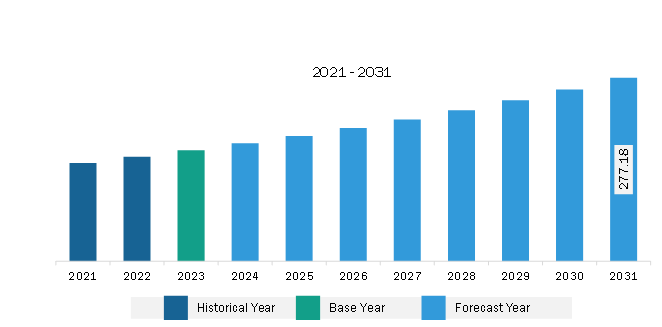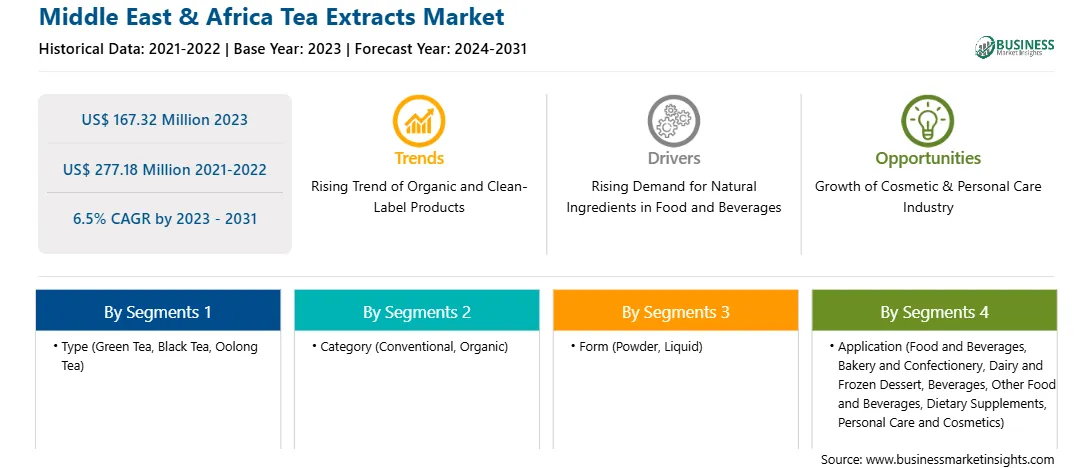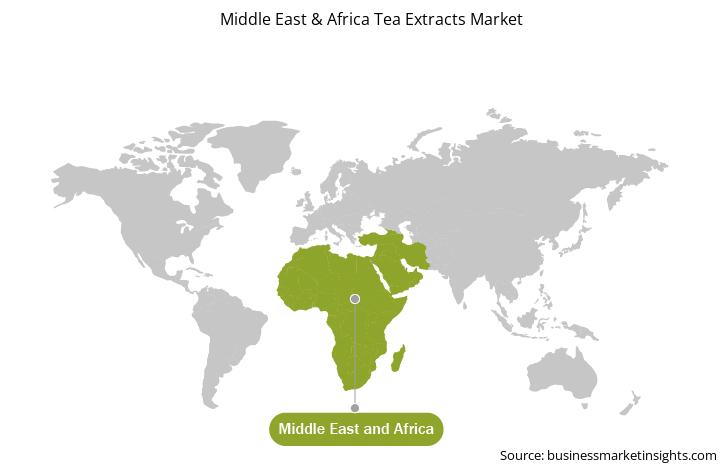The Middle East & Africa tea extracts market was valued at US$ 167.32 million in 2023 and is expected to reach US$ 277.18 million by 2031; it is estimated to register a CAGR of 6.5% from 2023 to 2031.
Consumers across the globe are leaning toward the adoption of a healthier lifestyle. Natural flavors can satisfy consumers' dietary requirements. Descriptions on menus and labels on food packaging highly influence consumer preferences. An understandable and clear label with thorough ingredient information attracts consumers to buy products. Companies' claims of natural ingredient content in the product on the front side of the packaging might attract a large number of consumers. Clean-label products are becoming increasingly popular as consumers prefer 100% natural products with no synthetic ingredients such as preservatives, artificial colors, flavors, etc. Virginia Dare Extract Co and Florida Food Products, Inc are among the companies that offer clean label tea extracts.
Organic products are cultivated naturally with manure or compost without chemical fertilizers and pesticides. Organic products are free of growth hormones, genetically modified ingredients (GMI), and antibiotic residues. The popularity of organic products such as organic tea has increased among health-conscious consumers owing to the rising awareness of their benefits. Organic tea farming comprises eco-friendly agricultural practices that result in higher crop yields. Many organic tea farming communities across Asian countries and other tea-cultivating economies follow organic farming practices to produce value-added organic products. Thus, manufacturers are launching organic tea extracts to cater to the increasing demand. For instance, in November 2022, Layn Natural Ingredients – manufacturer of botanical extract ingredients, launched tea extracts in organic form.
A few end-use industries such as personal care, food and beverages, and nutraceuticals employ organic tea extract to ensure the offering of sustainable products free of genetically modified organisms (GMOs) or any other questionable ingredients. Organic products offer a significant competitive advantage to tea extract manufacturers, enhancing their brand awareness and profitability.
Thus, the rising demand for organic and clean-label products is expected to create a new trend in the tea extracts market during the forecast period.
In terms of value, the tea extracts market in Rest of Middle East & Africa was valued at US$ 94.87 million in 2023 and is projected to reach US$ 149.61 million by 2031; it is expected to register a CAGR of 5.9% from 2023 to 2031.
Turkey, Kuwait, Qatar, Bahrain, Oman, and Kenya are among the major countries in the Rest of Middle East & Africa tea extracts market. Growing health consciousness, the cultural significance of tea, and product innovation across various industries, drives the tea extracts market. The rise in disposable incomes in Gulf states fuels the demand for premium tea extract-based products, while tourism exposes the consumers to diverse tea cultures. Countries with strong tea production capabilities, such as Kenya, are exploring opportunities in the tea extracts market for both domestic use and exports. These factors collectively shape the dynamic landscape of the tea extracts market.
Strategic insights for the Middle East & Africa Tea Extracts provides data-driven analysis of the industry landscape, including current trends, key players, and regional nuances. These insights offer actionable recommendations, enabling readers to differentiate themselves from competitors by identifying untapped segments or developing unique value propositions. Leveraging data analytics, these insights help industry players anticipate the market shifts, whether investors, manufacturers, or other stakeholders. A future-oriented perspective is essential, helping stakeholders anticipate market shifts and position themselves for long-term success in this dynamic region. Ultimately, effective strategic insights empower readers to make informed decisions that drive profitability and achieve their business objectives within the market. The geographic scope of the Middle East & Africa Tea Extracts refers to the specific areas in which a business operates and competes. Understanding local distinctions, such as diverse consumer preferences (e.g., demand for specific plug types or battery backup durations), varying economic conditions, and regulatory environments, is crucial for tailoring strategies to specific markets. Businesses can expand their reach by identifying underserved areas or adapting their offerings to meet local demands. A clear market focus allows for more effective resource allocation, targeted marketing campaigns, and better positioning against local competitors, ultimately driving growth in those targeted areas.
Middle East & Africa Tea Extracts Strategic Insights

Middle East & Africa Tea Extracts Report Scope
Report Attribute
Details
Market size in 2023
US$ 167.32 Million
Market Size by 2031
US$ 277.18 Million
Global CAGR (2023 - 2031)
6.5%
Historical Data
2021-2022
Forecast period
2024-2031
Segments Covered
By Type
By Category
By Form
By Application
Regions and Countries Covered
Middle East and Africa
Market leaders and key company profiles
Middle East & Africa Tea Extracts Regional Insights

The Middle East & Africa tea extracts market is categorized into type, category, form, application, and country.
Based on type, the Middle East & Africa tea extracts market is segmented into green tea, black tea, oolong tea, and others. The green tea segment held the largest market share in 2023.
In terms of form, the Middle East & Africa tea extracts market is bifurcated into powder and liquid. The liquid segment held a larger market share in 2023.
By application, the Middle East & Africa tea extracts market is segmented into food and beverages, bakery and confectionery, dairy and frozen dessert, beverages, other food and beverages, dietary supplements, personal care and cosmetics, and others. The food and beverages segment held the largest market share in 2023.
By category, the Middle East & Africa tea extracts market is bifurcated into conventional and organic. The conventional segment held a larger market share in 2023.
By country, the Middle East & Africa tea extracts market is segmented into the UAE, South Africa, Saudi Arabia, and the Rest of Middle East & Africa. The Rest of Middle East & Africa dominated the Middle East & Africa tea extracts market share in 2023.
Finlays, Botanic Healthcare Group, Martin Bauer GmbH & Co KG, Firmenich International SA, Givaudan SA, International Flavors & Fragrances Inc, Kerry Group Plc, Archer Daniels Midland Company, Sensient Technologies Corp, Kemin Industries Inc, Medikonda Nutrients, Virginia Dare Extract Co Inc, Lipoid-Kosmetik, Florida Food Products, and Dohler GmbH are some of the leading companies operating in the Middle East & Africa tea extracts market.
The Middle East & Africa Tea Extracts Market is valued at US$ 167.32 Million in 2023, it is projected to reach US$ 277.18 Million by 2031.
As per our report Middle East & Africa Tea Extracts Market, the market size is valued at US$ 167.32 Million in 2023, projecting it to reach US$ 277.18 Million by 2031. This translates to a CAGR of approximately 6.5% during the forecast period.
The Middle East & Africa Tea Extracts Market report typically cover these key segments-
The historic period, base year, and forecast period can vary slightly depending on the specific market research report. However, for the Middle East & Africa Tea Extracts Market report:
The Middle East & Africa Tea Extracts Market is populated by several key players, each contributing to its growth and innovation. Some of the major players include:
The Middle East & Africa Tea Extracts Market report is valuable for diverse stakeholders, including:
Essentially, anyone involved in or considering involvement in the Middle East & Africa Tea Extracts Market value chain can benefit from the information contained in a comprehensive market report.